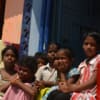
Rape has been used as a weapon of war in conflicts all over the world. And has been used against women and girls caught up in the massive humanitarian crisis involving Rohingya refugees.
In the past few months, nearly 600,000 Rohingya have fled Myanmar for Bangladesh, and more continue to seek refuge every day. The camps are overcrowded. The smell of waste and small fires for cooking and sweat hangs in the humid, thick air. Tents fashioned out of reeds and tarps perch precariously in the mud. Throngs of people crowd the latrines and newly dug wells. And these conditions are better than those in the makeshift camps, where thousands of unregistered refugees are living.
Every day, women — overwhelmed and exhausted by the journey from Myanmar — sit on roadsides with their children, not knowing where to go. Almost all have been through horrors that most of us can’t imagine and shudder to think about. There are thousands of pregnant women and adolescent girls living in the camps in Bangladesh.
See more Devex coverage of the Rohingya crisis:
► Aid groups 'desperate' to communicate effectively with 1 million Rohingya refugees
► In troubled Rakhine state, access slowly begins opening up again
► UN's Patten calls for independent probe on Rohingya crisis
► An alternative to 'refugee camp, then repatriation' strategy for Rohingya crisis?
► In Bangladesh, did groups build emergency latrines for Rohingya refugees — or for donors?
According to the United Nations Population Fund, the lead U.N. agency addressing gender-based violence in humanitarian settings, there are "horrific" accounts of rape and sexual assault against Rohingya women and girls fleeing Myanmar. And the agency says those stories could be "just the tip of the iceberg." Clearly, these women and girls have acute reproductive health needs. They need safe abortion — referred to as menstrual regulation, which is legal in Bangladesh — and postabortion care, because many of them have suffered serious injuries after desperately trying to end a pregnancy with harmful methods.
But the fact is, every woman and girl in these camps has reproductive health needs, yet those services are often minimal or nonexistent in crisis settings.
Indeed, the initial, much-needed public health response to the Rohingya crisis did not focus on these concerns. In partnership with UNFPA, Ipas Bangladesh made an effort to improve access to reproductive health services. We have sent trainers to health facilities in the camps and to government health facilities for the many refugees who are living outside the camps, in Cox’s Bazar district. Paramedics, midwives, and doctors who go through the short training will now provide postabortion care and menstrual regulation.
“By not providing comprehensive reproductive health care, including contraception and safe abortion services, humanitarian agencies have taken a side.”
—We had to move fast and coordinate with the country’s health system, the government and international aid agencies. We had to send trainers to the camps, because we couldn’t pull health providers out. The enormity of the crisis is overwhelming. But then again, so is the need for this care.
Why is reproductive health care so often neglected in humanitarian camps? One major factor is the stigma that surrounds abortion, even in a crisis.
International human rights bodies have clearly articulated the need to ensure that women everywhere have the right to abortion care that is safe, accessible, and of high quality. But within the humanitarian community, many say the provision of abortion care runs afoul of the basic humanitarian principles of humanity, neutrality, impartiality, and independence. These principles were devised in response to armed conflict. Why apply them to a basic medical procedure such as abortion? And beyond that, isn’t the first tenet of humanitarian assistance to alleviate suffering?
The Rohingya women and girls who have suffered sexual torture and humiliation and have now fled their homes most certainly deserve whatever care may alleviate some of their suffering. By not providing comprehensive reproductive health care, including contraception and safe abortion services, humanitarian agencies have taken a side, the side that opposes women’s human rights, the side that opposes science and common sense, the side that flies against established international agreements. Doing nothing speaks volumes.
As the number of women and girls living in humanitarian settings around the world continues to swell, we need more than ever to overcome abortion stigma and step up our efforts to ensure that reproductive health services are integrated into humanitarian response programs. The absence of safe abortion care in refugee settings constitutes discrimination against women. Among other harms, this discrimination exposes women to a risk that men will never experience — the risk of an unsafe abortion, which kills 45,000 women each year and injures millions more.
In Bangladesh, our work in the Rohingya camps has support from the government and various aid agencies. It is possible to offer reproductive health services, including menstrual regulation, quickly. We’ve established services in eight facilities so far and hope to set up more. Let this be a model for other countries, governments, donors, and aid groups.
Starting now, we must make sure that providers trained in safe abortion and postabortion care are available in all humanitarian settings. There must be contraception, including long-acting reversible methods, available in all facilities in those settings. A clear protocol and strategy for getting this accomplished is already in place, but it’s rarely implemented. What’s desperately needed is international consent, support, and funding for making these services available as soon as possible in crisis settings.
This is a big challenge, for sure. Women and girls in crisis settings of course need food, clean water, and a safe shelter. They also need essential health care that includes safe abortion and contraception. Human rights are not rooted in any one place, they are portable. When a Rohingya woman flees her home, her basic humanity goes with her — and might be the only thing that can save her life. But only if the world respects her rights and makes them a reality.
Read more Devex coverage of the Rohingya crisis.





